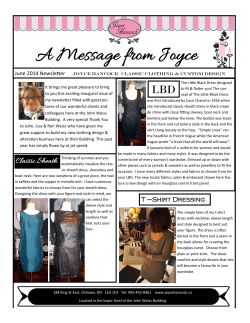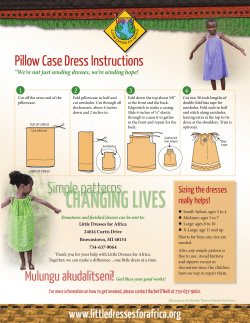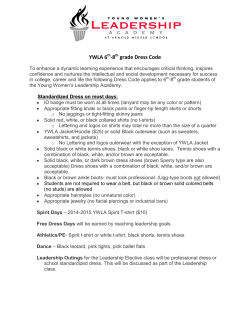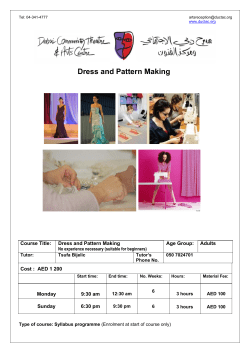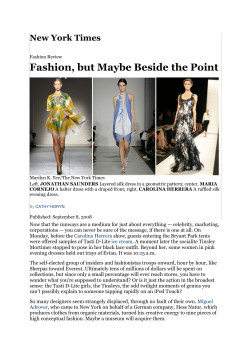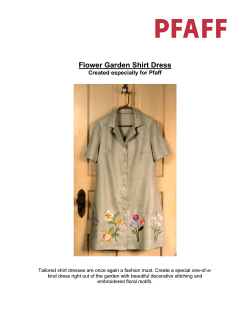
Dress, Popular Culture and Social Action in Africa Northwestern University
Conference on Dress, Popular Culture and Social Action in Africa Northwestern University March 13 - 14, 2009 “Dress practices are always and everywhere situated,” observed Karen Tranberg Hansen at the opening of the conference. These may serve, she continued, to contest or legitimate existing power structures through expression of one’s individual identity and through embracing or challenging the cultural and political context. These comments set the stage for the variety of discussions that would evolve over the course of two days. Bennetta Jules-Rosette of the University of California, San Diego, delivered the keynote lecture, in which she provided an overview of actress Josephine Baker’s career and further explored the links between image and power structures. Jules-Rosette’s central theme was Baker’s “selfrefashioning” as a form of activism. Baker’s costumes and personas challenged conceptions of race and gender, reversing codes through crossdressing and such characters as the black- and white-face clowns. Jules-Rosette stressed the growth in tandem of Baker’s political consciousness and control of her own image, and by extension suggested linkages between image and social action. The first session explored dress as a means of social action. Leslie W. Rabine examined spontaneous political photography of Senegal and Mali’s first presidents, while Victoria Rovine explored the use of plastic “China bags” in South African performance art, and Katherine Wiley discussed the continued importance of indigenous hand-dyed veils to Mauritanian women in a modern economy. As the discussants noted, each panelist characterized dress practices as a means of communicating identity through mundane objects. The practices surrounding the purchase of a veil, or the meaning communicated EACH PANELIST CHARACTERIZED through a leader’s opting DRESS PRACTICES AS A MEANS for traditional over Western OF COMMUNICATING IDENTITY clothing, may thus stabilize or challenge social THROUGH MUNDANE OBJECTS networks. As may be the mark of any successful conference, the day’s presentations did more to problematize than settle the relationship beThe final lecture of the day came from Zimbatween fashion and social change. Aside from bwean graphic artist Chaz Maviyane-Davis, who Maviyane-Davis’ exposition, suggestions of presented images based on the Universal Declatangible impacts of dress on politics were tentaration of Human Rights. Like that of earlier pretive. While Rabine hinted at a unifying effect of senters, Maviyane-Davis’ work used mundane political imagery on the polity, objects to convey soIF DESIGN CAN BE USED TO SELL she conceded that the less visucio-political messages. ally imposing of her presidents JEANS, IT CAN BE USED TO Unlike them, Maviyaloomed larger in history, raisne-Davis suggests that PROMOTE JUSTICE ing questions about the causal design can act as an power of dress on political immediate catalyst for outcomes. political reform from below by instilling a deYet Maviyane-Davis’ more ambitious proposimand for observation of human rights in indition must be seen in light of political resistance vidual citizens where enforcement from without to his work, which serves as a reminder that is unlikely to transpire, much less succeed. even potential catalysts for change exist within Maviyane-Davis’ proposition is that “if design definite power structures that may limit their can be used to sell jeans, it can be used to proefficacy. mote justice.” A panel entitled “Uniforms, Contemporary Fashion, and Enactments of Display” got us going bright and early on Saturday morning. The three presenters’ papers all problematized the “local” in transnational terms. Keith Rathbone, of Northwestern University’s History Department, discussed how Pa Kande and Bakary Diallo, two Senegalese World War I veterans, mobilized their military uniforms to reshape moral imagination and alter colonial discourse, and ultimately to reshape relationships between Europeans and Africans. Idioms of authority and prestige also allowed them to undermine previous social hierarchies. Though there existed tensions between inclusion and exclusion and although uniforms sometimes served to reify racial prejudice and images of ‘the’ African as exotic, Rathbone argues that West Africans who served in World War I, more often than not, wore the same uniforms as French soldiers. This not only reshaped relationships between Europeans and West Africans, but also created solidarity among West Africans beyond ethnic affiliations. In her paper Kelly A. Kirby, of the Department of Anthropology and Museum Studies at the University of Michigan, discussed how cloth, fashion and social display in Dakar, Senegal, establish social hierarchies, merge social and individual identities and create illusions of personal wealth. She also showed how skillful cloth-coloring in particular provides livelihood strategies for women who might otherwise have struggled to provide for themselves and their families. Chris Richards, of the Department of Art History at the University of Florida, discussed clothing in contemporary South African art by looking at the work of Nontsikelelo ‘Lolo’ Veleko, Lawrence Lemaoana, Mary Sibande and Athi-Patra Ruga. In this paper fashion featured as social signifier and a form of visual communication that actively questions norms of gender and race as social constructions. The three presentations on the panel “Visuality, Hip Hop, and Dress Performance” highlighted underlying themes of ambition, social mobility, and politics oriented towards the local, national, or global through examples from West In her analysis of the photographs of Seydou Africa. The presenters used photographs to ilKeita and Malick Sidibé, Candace Keller highlustrate the manifestation of these themes in the lighted the role of photographer and youth forms of dress to draw attention to meticulous together in creating compositions that illuschoices in fabric, posture, and, accessories and trated social and political sentiments in postother props. First, Misty Bastian introduced us Independence Mali. This analysis drew from to Nwanneka, an Igbo woman whose manner of two Bambara terms: badenya, or social cohedress announced her ambition for social mobility sion and stability and fadenya, or competition in the Igbo community. Jewelry, hair, purses, and and ambition. Analyzed in these two terms, a variety of fabrics were featured in Nwanneka’s the photographs brought greater meaning to dress and announced both her ambition and the vocabulary of clothing, gesture, props, and arrival at a change of status. However, Bastian composition. For example, Keller examined the also indicated choices of Western versus tradiTHE PHOTOGRAPHS BROUGHT that ultimately tional clothing or props, matched GREATER MEANING TO THE VOCABU- or unmatched clothing among ageNwanneka’s ambitions were LARY OF CLOTHING, GESTURE, PROPS, mates or couples, and the orientanot realized tion of gestures, poses or group AND COMPOSITION and her hopes arrangements. The themes of were decimatbadenya and fadenya problematize ed when her house was robbed of all of its fine the use of traditional and Western elements and fabrics and jewelry. The story of Nwanneka serves enriches an understanding of how youth and as a reminder that dressing for success is never a artist imagined their relationship to the Malian guarantee, for as much as it might attract admination. ration and respect, it can also attract jealousy or criminality. The following session, “Festivals, Representation, and the Moral Economy of Dress,” again called attention to political climates and modes Turning from the national to the global, Adeline of dress. Lauren Adrover displays of chiefly Masquelier’s paper examined how hip-hop culpower during processions of the traditional ture is re-contextualized by Muslim Youth in NiGhanaian festival in Cape Coast, Fetu Afahye. ger. In their preference for hip-hop music, blue Her discussion focused on the choice of t-shirts jeans, t-shirts, and sunglasses, the male youth worn by the festival participants, with disdisplayed their desire to be branché (connectplaying corporate logos or pictures of a chief. ed) as well as their suspicion towards the suAdrover illustrates that even the banal prolifperficiality of traditional clothing and outward eration of corporate t-shirts can highlight the expressions of Muslim piety. While many of the significance of how chiefly power might orient youth adhered less strictly to the rules of Islam, towards a complicated combination of local, natheir choices tional or global sources. While EVEN THE BANAL PROLIFERATION OF in dress and Adrover’s presentation illusCORPORATE T SHIRTS CAN HIGHLIGHT THE behavior retrated an acceptance of forSIGNIFICANCE OF HOW CHIEFLY POWER flected a critieign sponsorship through its cal attitude to MIGHT ORIENT TOWARDS A COMPLICATED recontexualization in Ghanatheir religion COMBINATION OF LOCAL, NATIONAL OR ian festivals, Catherine Bolten rather than a examined a rejection of new GLOBAL SOURCES rejection of forms of youth employment it. While discussions following the presentain the post-War Sierra Leone. While Bolten’s tion focused on the connection of hip-hop as a presentation on “bluff culture” in Sierra Leone subversive style in the United States and other contained many connections to previous dislocations, Masquelier’s example highlights the cussions on generational attitudinal differences process of mediation in a way that problemtatowards what constitutes, her paper gave spetizes hip-hop’s recontextualization. While the cial attention to the ways that youth adapted Nigerien youth drew upon hip-hop styles for to a difficult economic climate and challenged dress and music, their attitude reflected more notions of “real work.” The “bluff” forms of dress of an interest in questioning Islam rather than a represented different gambles for young womrejection of it. en and men in realizing their ambitions. Overall, Bolten highlights the significance of popular dress in even a post-war context as a way to examine how youth strategically navigated the social and economic difficulties. In the discussion that followed, Benjamin Soares called for both presenters to consider the role of religion in shaping patterns of dress. One of the most interesting comments, however, can from Dr. Sandra Richards of African American Studies who asked audience members examine how they are “dressed” for this conference; indeed, many conference attendees sported interesting combinations of American or African clothing and accessories over the two-day period. She reminded researchers that dress should always considered as a matter of personal taste and self-expression. Her comment created a wonderful segue into a presentation by Phil Sandick of his photographs of students from a high school in Botswana. The students were allowed one day a year to abandon their uniforms and dress as they pleased, and the unique combinations of clothing styles evidenced in the photograph was a reminder of the fun and creativity of dressing up. While dress is often the expression of political, social, and economic circumstances or the constraints of age or religion, it is also opens up a space by which people might express their own unique character and personality. Nina Sylvanus of the Department Anthropology at Reed College presented on printed The last panel discussed “Spiritual Power, Dress cloth, counterfeiting and fashion in Togo. and Authenticity.” Dorothea E. Schultz of the Sylvanus argues that counterfeiting has Department Religious Studies at Indiana Uni- made for a crisis of representation. Women’s wrappers are heritage but also indexes of versity presented first and spoke about the mediation of spiritual power through dress in hierarchy. But as Chinese goods flooded newly opened markets, Muslim West WOMEN’S WRAPPERS ARE HERITAGE BUT notions of product Africa. Drawing ALSO INDEXES OF HIERARCHY authenticity came to be on fieldwork questioned. Reliable sigconducted in nifiers are consequently Bamako, Mali, Schultz unpacks the role of dress in the mate- breaking down resulting in values and signs being redefined. Provocatively, counterfeitrial lives of Muslim women. Choice of dress constitutes an element of identity politics and ing can almost be read as democratization. shows moral reform. It demarcates its wearer Professor Joanne B. Eicher made concluding as an African Muslim woman, and is a modality remarks about how limited our knowledge of pious self making. Though it is supposed to is and that a multidisciplinary approach to act as a leveler, acceptable forms of dress does dress is still in its infancy. Pointing to the way not completely do away with inequalities and forward, Professor Eicher stressed the imporeconomies of hierarchy as subtle differences tance of the everyday and the commonplace in dress can still be perceived by a discerning and attention to fine details. eye. Th i s co n fe re n ce has been o rgani zed as par t of the Program of African Studies 60th Anniversar y by Professors K aren Tranberg Hansen (Anthropology) and D. S oy i n i M a di s o n (Per fo rmance Stu di es ) Graduate Student Organizers: Andrea Felber Seligman (History), Lauren Adrover (Anthropology), Bethlehem Dejene (Anthropology), Alana Glaser (Anthropology), Ariel Bookman (English) Sponsored by The Graduate School, The Program of African Studies, The Buffett Center for International and Comparative Studies and The Department of Anthropology Front cover photo courtesy of Lauren Adrover
© Copyright 2025
